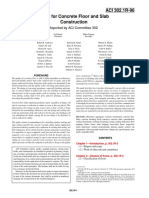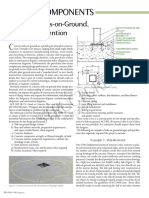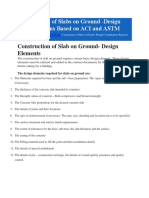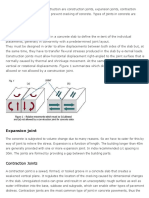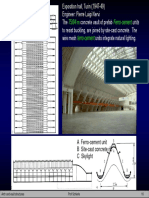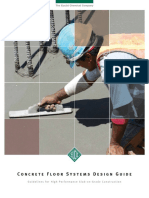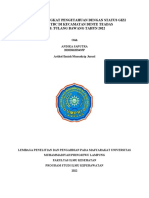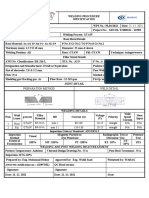Base Concrete Placement: 1. Subgrade
Uploaded by
apuhapuh_153349Base Concrete Placement: 1. Subgrade
Uploaded by
apuhapuh_153349Base Concrete Placement
Production of a quality concrete slab requires proper
techniques and adequate planning. The following key
areas have been identified as the most critical to achieving
a satisfactory result. References to ACI Guide for Concrete
Floor and Slab Construction are given where appropriate.
1. Subgrade
The subgrade must be properly compacted and drained in
order to give the bearing support assumed in design. Without
support, the slab has little chance of supporting design loads
(Section 3.1). Maximum deflection under a fully loaded ready rectangular, or diamond-shaped. Diamond dowels are
mix truck should be 1/2 (13 mm). recommended for construction joints as they have movement
in four directions. Round dowels are not as effective in
2. Vapor Barrier/Vapor Retarders restricting curling because of the installation procedure,
Any slab-on-ground that will be covered by materials such as which results in a sleeve, or larger than desirable cavity, and
linoleum, wood, carpet, and non-breathable coatings should be there is no movement allowed in the direction perpendicular
protected from the transmission of moisture and vapor upward to the dowels. Dowels should be properly aligned and smooth
through the slab from sources in the base and sub-base. so that the joint can open as the concrete shrinks. Support
should be provided to dowels during the concrete placement
Vapor barriers and vapor retarders are used to minimize and finishing operations so that they remain parallel in both
moisture and vapor transmission. ASTM E 1745 lists planes (horizontal and vertical).
performance requirements for plastic vapor retarders. The
type of vapor barrier/retarder selected is based on the amount Keyed joints do not provide effective load transfer, and
of protection required and the moisture sensitivity of the floor should not be used in areas of heavy traffic loads.
covering to be installed. Vapor barriers/retarders can be placed
directly beneath and in contact with the concrete slab, or a 5. Isolation Joints
layer of granular fill may be installed between the concrete Preformed joint materials are used to create isolation joints
and the barrier/retarder. Direct placement of concrete on between the floor and walls, columns, equipment foundations,
top of a vapor barrier can contribute to problems such as footings, drains and other separate building members. Isolation
plastic and drying shrinkage cracking and curling. joints allow for freedom of movement of the floor independent
of these building elements. Figures 3.4, 3.5, and 3.6 in ACI 302
Each vapor barrier/retarder installation should be evaluated illustrate the different types of isolation joints used.
on an individual project basis. Figure 3.2 in ACI 302 should
be used to assist in making decisions regarding vapor barrier/ 6. Admixtures
retarder placement. Low w/cm mixes are often used to reduce Admixtures are used to effect a specific improvement in the
the time required for the concrete to reach a moisture level properties of freshly mixed or hardened concrete. Admixtures
suitable for an adhesive application. should be used in accordance with the instruction and principles
provided in ACI 212.1R and 212.2R with attention to the
3. Contraction (Control) Joint Location guidelines for chloride limits given in ACI 302.1R-04, Section 5.7.3
Contraction joints are normally located on column lines with (also check recommendations on chloride limitations in ACI 201
additional intermediate joints located equally spaced between and ACI 318). Testing should be performed to determine how
column lines. See Figure 3.3 of ACI 302 for details. There are the admixture(s) will affect the properties of the concrete given
several factors to consider when designing the spacing of the specified job materials, as well as the anticipated conditions
contraction joints including the thickness of the slab, location and construction procedures. Often, admixtures are used in
and type of reinforcement, potential for slab shrinkage, combination with one another. A second admixture can
and many others. In unreinforced slabs, contraction joints significantly affect the dosage requirement of both admixtures.
should be spaced in feet, 2 - 3 times the slab thickness up to a Preliminary tests are recommended to ensure the optimum
maximum of 18 ft. Spacing in reinforced slabs can be slightly dosage of each admixture. Successful placements onsite will
increased beyond the recommendation for unreinforced slabs verify proper workability, finishability and setting time.
when a low shrinkage mix design is used. Dowel baskets can be
used to give support to joint dowels and maintain alignment. It is important to consult the manufacturer and
Often, structural fibers are used in these slabs to hold cracks applicable MSDS for specific material handling, dosage
tight. Consult ACI 360R for specific details regarding design and application instructions.
and spacing of contraction joints.
Admixture(s) that are used in concrete should meet the
4. Construction Joints appropriate specifications (see page 7 of this guide).
Construction joints are used where individual concrete
placements meet. Each joint should be located at least 5 ft. 7. Air Entrainment
(1.5 m) or more from any other joint to which it is parallel. Proper air entrainment is required for exterior slabs subject to
freeze/thaw cycles and de-icing salts (Section 6.2.3). However,
If hard-wheeled traffic or heavy loads are expected to travel for interior industrial slabs, air entrainment is not desirable
over construction joints, dowels are recommended to tie the because of adverse effects on finishability and difficulty in
slabs together so that both sides of the joint are displaced applying surface hardeners. Air content should not exceed
equally when under load. Dowels can be round, square, 3% for these types of slabs.
You might also like
- Handbook of Sustainable Concrete and Industrial Waste ManagementNo ratings yetHandbook of Sustainable Concrete and Industrial Waste Management6 pages
- Guide For Design of Slab-Column Connections in Monolithic Concrete Structures75% (4)Guide For Design of Slab-Column Connections in Monolithic Concrete Structures4 pages
- ACI 302.1R-96 Guide For Concrete Floor and Slab ConstructionNo ratings yetACI 302.1R-96 Guide For Concrete Floor and Slab Construction67 pages
- A Guide For Durable Quality Residential Concrete Flatwork 2016 RevisionNo ratings yetA Guide For Durable Quality Residential Concrete Flatwork 2016 Revision4 pages
- Synthetic Fibers 12. Surface Tolerances (Based On ACI 302, Section 8.15)No ratings yetSynthetic Fibers 12. Surface Tolerances (Based On ACI 302, Section 8.15)1 page
- ACI 224.3R-95 Joints in Concrete Slabon Grade[1]No ratings yetACI 224.3R-95 Joints in Concrete Slabon Grade[1]5 pages
- 03 3300 Concrete Recommendations With Polished Concrete (Version 1)No ratings yet03 3300 Concrete Recommendations With Polished Concrete (Version 1)5 pages
- 80f16941-Performance Floors for Warehouses and Distribution CentresNo ratings yet80f16941-Performance Floors for Warehouses and Distribution Centres16 pages
- ACI 3259r - 91 - Guide For Construction of Concrete Pavements & Bases100% (1)ACI 3259r - 91 - Guide For Construction of Concrete Pavements & Bases27 pages
- نسخة من 325.12R-02 Guide for Design of Jointed Concrete Pavements for Streets and Local Roads100% (1)نسخة من 325.12R-02 Guide for Design of Jointed Concrete Pavements for Streets and Local Roads36 pages
- Performance Floors For Warehouses and Distribution CentresNo ratings yetPerformance Floors For Warehouses and Distribution Centres16 pages
- Concrete Slab Floors: The Benefits of Concrete SlabsNo ratings yetConcrete Slab Floors: The Benefits of Concrete Slabs4 pages
- (AOSM - DOC - CA - 14) ACI 421.3R-15 Guide To Design of Reinforced Two-Way Slab Systems PDFNo ratings yet(AOSM - DOC - CA - 14) ACI 421.3R-15 Guide To Design of Reinforced Two-Way Slab Systems PDF32 pages
- Guideline Suggestions For Specification of Concrete Slab-On-Grade Substrates To Receive Epoxy TerrazzoNo ratings yetGuideline Suggestions For Specification of Concrete Slab-On-Grade Substrates To Receive Epoxy Terrazzo2 pages
- SAES-Q-001 (Criteria For The Design & Construction of Concrete Structures)100% (2)SAES-Q-001 (Criteria For The Design & Construction of Concrete Structures)5 pages
- Table of Design Parameters: Concrete Parameters Suggested Minimum Thickness Slump Air Content AdmixturesNo ratings yetTable of Design Parameters: Concrete Parameters Suggested Minimum Thickness Slump Air Content Admixtures1 page
- SAES-Q-001 SAES-Q-001: Criteria For Design and Construction of Concrete StructuresNo ratings yetSAES-Q-001 SAES-Q-001: Criteria For Design and Construction of Concrete Structures6 pages
- Design of Slabs-On-Ground 360R-35: Fig. 8.4-Calculated Compressive Stresses Induced by Expansion (From ACI 223)No ratings yetDesign of Slabs-On-Ground 360R-35: Fig. 8.4-Calculated Compressive Stresses Induced by Expansion (From ACI 223)1 page
- Design and Application Guide For Flooring and Wall SystemsNo ratings yetDesign and Application Guide For Flooring and Wall Systems63 pages
- Reference - Joints in Concrete Construction, ACI 224No ratings yetReference - Joints in Concrete Construction, ACI 2242 pages
- Road to Excellence Advanced Concepts in Highway Engineering (Part-3)From EverandRoad to Excellence Advanced Concepts in Highway Engineering (Part-3)No ratings yet
- Arch and Vault Structures Prof Schierle 19No ratings yetArch and Vault Structures Prof Schierle 191 page
- Arch and Vault Structures Prof Schierle 14No ratings yetArch and Vault Structures Prof Schierle 141 page
- Arch and Vault Structures Prof Schierle 8No ratings yetArch and Vault Structures Prof Schierle 81 page
- Arch and Vault Structures Prof Schierle 18No ratings yetArch and Vault Structures Prof Schierle 181 page
- Arch and Vault Structures Prof Schierle 15No ratings yetArch and Vault Structures Prof Schierle 151 page
- Arch and Vault Structures Prof Schierle 13No ratings yetArch and Vault Structures Prof Schierle 131 page
- Arch and Vault Structures Prof Schierle 3No ratings yetArch and Vault Structures Prof Schierle 31 page
- Arch and Vault Structures Prof Schierle 11No ratings yetArch and Vault Structures Prof Schierle 111 page
- 1 Two-Hinge Arch 2 Three-Hinge Arch 3 Crown Hinge Concealed 4 Crown Hinge Exposed 5 Base Hinge Concealed 6 Base Hinge Exposed 7 Base Moment Joint Concealed 8 Base Moment Joint ExposedNo ratings yet1 Two-Hinge Arch 2 Three-Hinge Arch 3 Crown Hinge Concealed 4 Crown Hinge Exposed 5 Base Hinge Concealed 6 Base Hinge Exposed 7 Base Moment Joint Concealed 8 Base Moment Joint Exposed1 page
- Arch and Vault Structures Prof Schierle 5No ratings yetArch and Vault Structures Prof Schierle 51 page
- Arch and Vault Structures Prof Schierle 7No ratings yetArch and Vault Structures Prof Schierle 71 page
- Arch and Vault Structures Prof Schierle 9No ratings yetArch and Vault Structures Prof Schierle 91 page
- Arch and Vault Structures Prof Schierle 4No ratings yetArch and Vault Structures Prof Schierle 41 page
- Arch and Vault Structures Prof Schierle 6No ratings yetArch and Vault Structures Prof Schierle 61 page
- Load Type Funicular 1+2 Single Point Load TriangleNo ratings yetLoad Type Funicular 1+2 Single Point Load Triangle1 page
- Special Floor Finishes: Product Usage Chart For Dry Shake Floor HardenersNo ratings yetSpecial Floor Finishes: Product Usage Chart For Dry Shake Floor Hardeners1 page
- Concrete Floor Systems Design Guide: The Euclid Chemical CompanyNo ratings yetConcrete Floor Systems Design Guide: The Euclid Chemical Company1 page
- Why Social Justice Matters 1st Edition Brian Barry all chapter instant download100% (4)Why Social Justice Matters 1st Edition Brian Barry all chapter instant download61 pages
- KDS 14 20 64 Design Standard For Structural Plain ConcreteNo ratings yetKDS 14 20 64 Design Standard For Structural Plain Concrete11 pages
- Learn: Half Yearly Examination (2013 - 2014) Class Ix Foundation of Information Technology Time: 3 Hrs. M.M.: 90No ratings yetLearn: Half Yearly Examination (2013 - 2014) Class Ix Foundation of Information Technology Time: 3 Hrs. M.M.: 9023 pages
- Pessing Libya INC: SA 312 TP 316 TO SA 312 TPNo ratings yetPessing Libya INC: SA 312 TP 316 TO SA 312 TP1 page
- AE Operation and Maintenance Manual of 170 Series Marine Diesel EngineNo ratings yetAE Operation and Maintenance Manual of 170 Series Marine Diesel Engine123 pages
- Lectures 1 - 10 Introduction To Classical Mechanics: Prof. N. Harnew University of Oxford MT 2016No ratings yetLectures 1 - 10 Introduction To Classical Mechanics: Prof. N. Harnew University of Oxford MT 2016102 pages
- Review Notes in Working Papers Review Notes in Working PapersNo ratings yetReview Notes in Working Papers Review Notes in Working Papers16 pages





